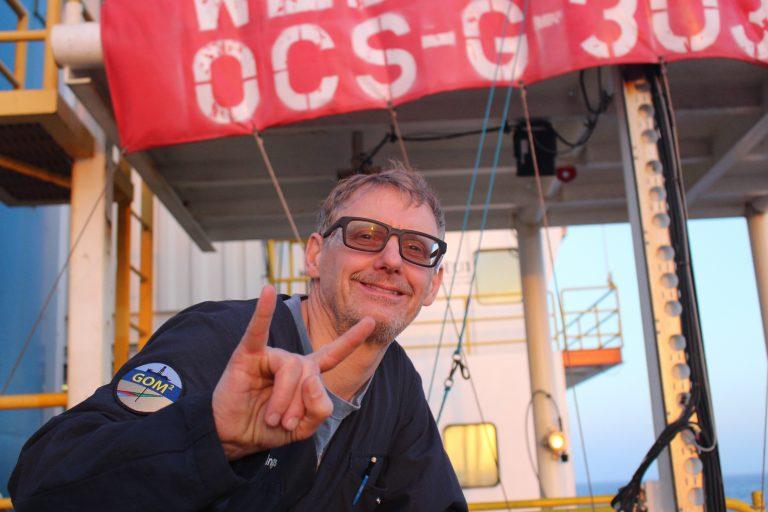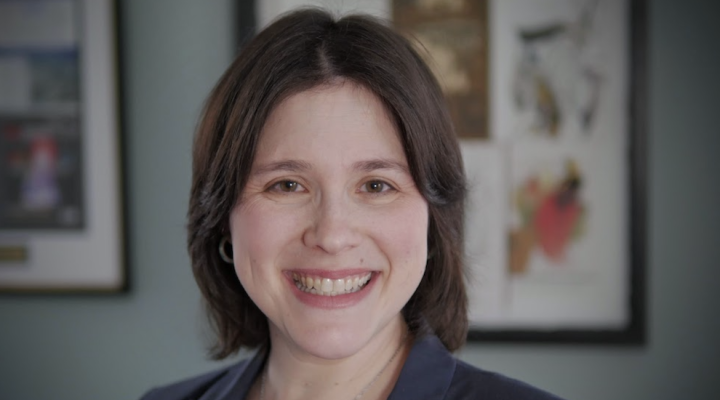By Chris Dawson
In the more than thirty years since Peter Flemings Ph.D. ’90 left Cornell with his Geology doctorate in hand, he has been engaged in research at some of the nation’s premier academic institutions, including the Lamont-Doherty Earth Observatory, MIT, Penn State University, and the University of Texas at Austin. In that time he has published a truly impressive 176 scholarly articles.
And yet, his most-frequently cited paper by far remains his first one: a 1989 paper he wrote as a grad student working under Cornell’s Terry Jordan. It is titled A synthetic stratigraphic model of foreland basin development and it is entirely fitting that this is Flemings’ most cited work. Fitting because Jordan played a hugely important role in his early development as a quantitative geoscientist and because the roots of much of Flemings’ subsequent work are evident in that early paper.
In a recent conversation Flemings told the story of how he ended up at Cornell for his doctoral studies and how that paper came about. “I cannot say enough good words about Terry Jordan,” Flemings said. “She had a last-minute opening in her group when another student changed his mind. She offered me the spot and I jumped at the chance. She met with me every week of my first year in Ithaca and we would talk about geology and her interests and my interests. Through those conversations we created a project for me out in the Wind River Basin of Wyoming.”
That project involved a very traditional approach to field geology. Flemings measured the thickness and the age of rock layers and investigated which way streams flowed that formed these deposits. Through this he put together a story about the geologic history of the Wind River Range. Through this he gained a deep understanding of stratigraphy. Flemings had planned on his Wind River work culminating in a terminal master’s degree and then a job in industry somewhere, but a funny thing happened.
“By being in Wyoming and touching and measuring the rocks I started to gain a real visceral sense of how these layers were deposited and how the land took on the shape it had,” Flemings said. “I was hooked, and I became interested in the theoretical side of how exactly these basins formed and filled.”
Rather than leave with a master’s degree, Flemings stayed at Cornell and began to incorporate some of the ideas of EAS faculty member Don Turcotte, who was a seminal leader in applying a quantitive, process-based, understand to a range of earth processes. “I took this physical observation of the Earth from my Master’s research and combined it with quantification of how mountain belts erode, sediments are transported, and how the lithosphere responds to loading, all based on Don Turcotte’s approach and the result was that paper: A synthetic stratigraphic model of foreland basin development.”
Flemings mentions Civil and Environmental Engineering Professor John Able specifically as someone who helped him understand and begin to master numerical methods and the writing of complex, coupled, computer simulations. He also remembers many long nights in the Snee Hall computer lab surrounded by graduate students who were seismologists, stratigraphers, and geomorphologists. Says Flemings “we talk about inter-disciplinarity every day now. However, this was rare in the 80’s and that dynamic mix was fundamental to my training”
There was an additional draw that convinced Flemings to continue on to his Ph.D. “I was literally just having too much fun doing this doctoral program. There are too many graduate students who aren't having fun. And at that point at Cornell most people in the graduate program were really excited about what they were doing, including me. I just didn't want to leave. It was fun trying to figure this stuff out. On top of that, there were frequent croquet matches at the Jordan-Allmendinger household and the famous Turcotte Open Golf Tournament that all added to the joy of those days. And so, even though there were job opportunities, it wasn't hard to stay.”
Once he earned his doctorate, Flemings briefly considered taking a job in the oil industry but in the end came back to academia. He simply enjoyed the research too much to leave it.
Flemings spent two years as a post-doc and an associate research scientist at Columbia’s Lamont-Doherty Earth Observatory where he delved into questions combining fluid flow with stratigraphy. Over time, his research became more sharply focused on fluid flow in basins and he spent a year as a post-doc at MIT before accepting a faculty position in the Geosciences at Penn State, where he stayed for 14 years.
Flemings has been at the University of Texas at Austin since 2007, where he is a professor in the Department of Earth and Planetary Sciences at the Jackson School of Geosciences and holds the John A. and Katherine G. Jackson Chair in Energy and Mineral Resources and the Leonidas T. Barrow Centennial Chair in Mineral Resources. His worked has continued to expand, taking in new areas of interest as the world’s priorities have shifted to focus increasingly on sustainability.
If you look at Flemings’ faculty page at the UT-Austin website, it still lists stratigraphy first among his areas of expertise but these days it includes a long list of other areas of interest including basin analysis, basin-scale fluid flow, pore pressures in seafloor sediments, submarine landslides, oil and gas migration, methane hydrates, and the Integrated Ocean Drilling Program (IODP).
For the past 24 years Flemings has led the GeoFluids Consortium, which is funded by major US and International energy companies and has as its focus studying the state and evolution of pressure, stress, deformation, and fluid flow in the subsurface. The results of the consortium’s work used to predict pressure and stress, design stable and safe drilling programs, and predict hydrocarbon migration and entrapment.
When the Deepwater Horizon blowout occurred at the Macondo well in 2010, leading to an 87-day flow of hydrocarbons directly into the Gulf of Mexico, Flemings was called to Houston within hours and spent months as part of the Federal Government’s ‘Well Integrity’ team. The team was charged with analyzing historical and real time data to make recommendations on how to plug the well and to monitor the well after it was plugged to ensure there was no downhole leakage.
During that same recent conversation, it became clear that Flemings is especially excited about his research into natural gas hydrate systems. Starting in 2005 Flemings started to turn his attention to methane hydrates. “I just wanted to understand the process of how methane percolates up through the ocean. It gets near the sea floor, where it's cold and the pressure is high, and it turns into this ice just like ice on a pond,” Flemings said. “Essentially, it's all sitting there within the first kilometer. And so I was interested in fluid flow. And this is kind of a classic reactive flow problem. The gas is slowing, but then there's a phase change, and it solidifies.”
Just like with his early work in the Wind River Range, Flemings saw an observed and well-documented geological system, but felt it could use some quantification. His early work challenged a popular interpretation that small changes in seafloor temperature could result in very large expulsions of methane into the ocean resulting in dramatic changes in climate. It turns out the Department of Energy agreed on the need for more information and explanation of methane hydrate systems and funded what became a $120 million project.
The project has resulted in several published volumes and some surprising discoveries. His work has confirmed that much of the methane in the deep oceans is created through microbial action. Another is that these hydrate bearing rocks demonstrate interesting material properties and behaviors that materials scientists are looking at more closely and that may contribute to landslides and other earth deformation.
Most recently, just last year, Flemings began to take core samples from the permafrost outside of Fairbanks, Alaska and he is finding some similarities to the deep ocean hydrates his team brought to the surface. The methane trapped in permafrost is generated by some of the same microbial processes as the deep ocean methane. If the oceans and permafrost start to quickly release the methane they store, that could have serious consequences for the global climate, so gaining a better understanding of the melting of the permafrost system and the resultant flux of methane and carbon dioxide into the atmosphere is a high priority for Flemings and for the world.
In June of 2023 Flemings came back to Cornell to be part of AndesFest, celebrating 40 years of research led by several Cornell EAS professors, including his beloved advisor Terry Jordan. All these years later, Flemings still has nothing but good things to say about Jordan and about his years at Cornell.





